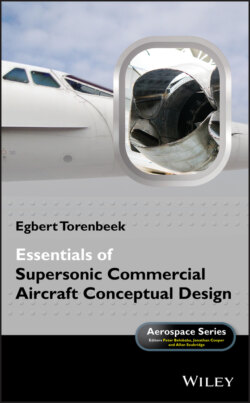Читать книгу Essentials of Supersonic Commercial Aircraft Conceptual Design - Egbert Torenbeek - Страница 13
1.3 Transonic Transport Configuration Studies
ОглавлениеThe history of near‐sonic cruise airliner designs dates back to the late 1950s. One of the concepts discussed by the British STAC was the M‐wing layout depicted in Figure 1.4, which was considered as an alternative to the slender wing. This novel configuration was primarily aimed at allowing cruise speeds near Mach 1.2 over land without producing a sonic boom. The M‐wing incorporated highly swept thin wing segments with forward sweep inboard and aft sweep outboard in combination with an area‐ruled fuselage1. Other design aspects were aimed at avoiding the poor aerodynamic efficiency and flying qualities at low speeds of a highly sweptback wing. The unusual inboard forward sweep was intended to compensate for the outboard sweep and the relatively high aspect ratio should contribute to avoiding the high vortex‐induced drag of a slender wing. The STAC rejected the M‐wing concept since the arguments in favor of a more ambitious Mach 2.0 cruise speed that dominated in the decision‐making process. Renewed interest in the development of transonic transport began in the mid 1960s when Boeing and Lockheed generated a series of study layouts based on highly swept wings and area‐ruled fuselages. These concepts complied with the principles of transonic flight successfully applied to fighters designed in the 1950s and the technology of supercritical wing sections developed at NASA‐Langley. It was also realized that a transport aircraft flying at Mach 1.12 in the standard atmosphere could fly without producing a sonic boom at ground level. Since wind and non‐standard temperatures change the boomless cruise speeds between Mach 1.05 and 1.25, a typical cruise speed for transonic flight is Mach 1.20. However, the irregular floor plan due to the mid‐cabin body waist made it difficult to configure the cabin according to the manner that individual customers would like, and thus formed an enduring drawback of this airplane concept.
Figure 1.4 The M‐wing layout for cruising at Mach 1.20, generated by the STAC in 1956.
By the early 1970s it was recognized that the higher fuel prices and risk of a transonic airplane development outweighed its potential benefits, an opinion that was widely held throughout the mid‐1990s. Around the year 2000 Boeing marketed a concept that was designed for extended ranges greater than 17,000 km, flying at cruise speeds of Mach 0.95 or above. It was derived from “slowing down” supersonic configurations rather than “speeding up” conventional subsonic configurations and became known as the “Sonic Cruiser”. This project came to an end after the events of September 2001, when airlines that were enthusiastic about the Sonic Cruiser initially were struggling for their survival.
